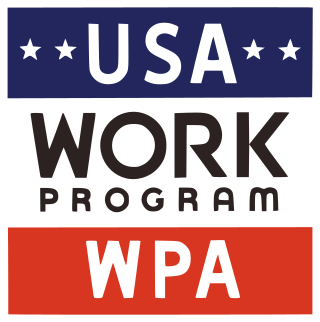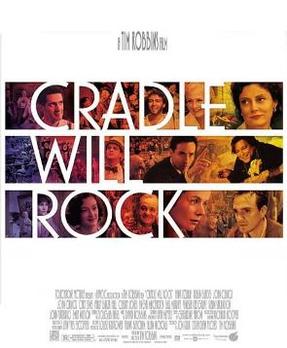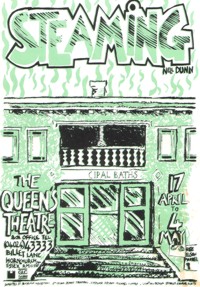
The Works Progress Administration was an American New Deal agency that employed millions of jobseekers to carry out public works projects, including the construction of public buildings and roads. It was set up on May 6, 1935, by presidential order, as a key part of the Second New Deal.

Joseph Walton Losey III was an American theatre and film director, producer, and screenwriter. Born in Wisconsin, he studied in Germany with Bertolt Brecht and then returned to the United States. Blacklisted by Hollywood in the 1950s, he moved to Europe where he made the remainder of his films, mostly in the United Kingdom. Among the most critically and commercially successful were the films with screenplays by Harold Pinter: The Servant (1963) and The Go-Between (1971).

The Federal Writers' Project (FWP) was a federal government project in the United States created to provide jobs for out-of-work writers during the Great Depression. It was part of the Works Progress Administration (WPA), a New Deal program. It was one of a group of New Deal arts programs known collectively as Federal Project Number One or Federal One.

The Federal Theatre Project was a theatre program established during the Great Depression as part of the New Deal to fund live artistic performances and entertainment programs in the United States. It was one of five Federal Project Number One projects sponsored by the Works Progress Administration, created not as a cultural activity but as a relief measure to employ artists, writers, directors, and theater workers. National director Hallie Flanagan shaped the FTP into a federation of regional theaters that created relevant art, encouraged experimentation in new forms and techniques, and made it possible for millions of Americans to see live theatre for the first time. Although The Federal Theatre project consumed only 0.5% of the allocated budget from the WPA and was widely considered a commercial and critical success, the project became a source of heated political contention. Congress responded to the project's racial integration and accusations of Communist infiltration and cancelled its funding effective June 30, 1939. One month before the project's end, drama critic Brooks Atkinson summarized: "Although the Federal Theatre is far from perfect, it has kept an average of ten thousand people employed on work that has helped to lift the dead weight from the lives of millions of Americans. It has been the best friend the theatre as an institution has ever had in this country."

Cradle Will Rock is a 1999 American historical drama film written, produced and directed by Tim Robbins. The story fictionalizes the true events that surrounded the development of the 1937 musical The Cradle Will Rock by Marc Blitzstein; it adapts history to create an account of the original production, bringing in other stories of the time to produce a social commentary on the role of art and power in the 1930s, particularly amidst the struggles of the labor movement at the time and the corresponding appeal of socialism and communism among many intellectuals, artists and working-class people in the same period.

The Cradle Will Rock is a 1937 play in music by Marc Blitzstein. Originally a part of the Federal Theatre Project, it was directed by Orson Welles and produced by John Houseman. Set in Steeltown, U.S.A., the Brechtian allegory of corruption and corporate greed includes a panoply of social figures. It follows the efforts of Larry Foreman to unionize the town's workers and combat the powerful industrialist Mr. Mister, who controls the town's factory, press, church, and social organization. The piece is almost entirely sung-through, giving it many operatic qualities, although Blitzstein included popular song styles of the time.

Hallie Flanagan Davis was an American theatrical producer and director, playwright, and author, best known as director of the Federal Theatre Project, a part of the Works Progress Administration (WPA).

Rose McClendon was a leading African-American Broadway actress of the 1920s. A founder of the Negro People's Theatre, she guided the creation of the Federal Theatre Project's African American theatre units nationwide and briefly co-directed the New York Negro Theater Unit.
Documentary theatre is theatre that uses pre-existing documentary material as source material for stories about real events and people, frequently without altering the text in performance. The genre typically includes or is referred to as verbatim theatre, investigative theatre, theatre of fact, theatre of witness, autobiographical theatre, and ethnodrama.

Norman Nathan Lloyd was an American actor, producer, director, and centenarian with a career in entertainment spanning nearly a century. He worked in every major facet of the industry, including theatre, radio, television, and film, with a career that started in 1923. Lloyd's final film, Trainwreck, was released in 2015, after he turned 100.

James Theodore Ward was a leftist political playwright and theatre educator during the first half of the 20th century and one of the earliest contributors to the Black Chicago Renaissance. Often referred to as the "dean of black dramatists," Ward was well known for tackling controversial topics related to African-American urban life during the Great Depression. His staged works were lauded for their innovative depiction of the black experience, most notably for doing away with the spiritual ballads and feverish dancing that dominated "Negro theatricals" of his time in favor of a more nuanced, naturalistic approach to plot and character.

Big White Fog is a play by American playwright Theodore Ward and his first major work. The play follows the fictional Mason family across three generations between 1922 and 1933. Half of the family supports a return to Africa and Garveyism, while the other half of the family seeks the American Dream.

Steaming is a 1981 play written by English playwright Nell Dunn first staged at Theatre Royal, Stratford East, in London. It won the 1981 Laurence Olivier Award for Best New Comedy.

The Voodoo Macbeth is a common nickname for the Federal Theatre Project's 1936 New York production of William Shakespeare's Macbeth. Orson Welles adapted and directed the production, moved the play's setting from Scotland to a fictional Caribbean island, recruited an entirely Black cast, and earned the nickname for his production from the Haitian vodou that fulfilled the role of Scottish witchcraft. A box office sensation, the production is regarded as a landmark theatrical event for several reasons: its innovative interpretation of the play, its success in promoting African-American theatre, and its role in securing the reputation of its 20-year-old director.

The Playhouse Theatre is a theater located at 4045 University Way NE on The Ave in the University District, Seattle, Washington. It was converted from a tile warehouse in 1930 by Burton and Florence James, who set up the Seattle Repertory Playhouse with multi-ethnic performers and audiences.

Can You Hear Their Voices? A Play of Our Time is a 1931 play by Hallie Flanagan and her former student Margaret Ellen Clifford, based on the short story "Can You Make Out Their Voices" by Whittaker Chambers. The play premiered at Vassar College on May 2, 1931, and ran most recently Off Broadway June 3–27, 2010. Broadway World notes that it anticipated John Steinbeck's The Grapes of Wrath and Clifford Odets' Waiting for Lefty, predating them by eight years and by four years respectively.

One Third of a Nation is a Living Newspaper play produced by the Federal Theatre Project in 1938. Written by Arthur Arent from research by the editorial staff of the Federal Theatre Project, it focused on the problem of housing in the United States and the growth of slums in New York City. The play was produced in New York and in nine additional cities, where it was adapted to specific community conditions. It was adapted as a feature film in 1939, and revived on the New York stage in 2011.
Arnold Olaf Sundgaard was an American playwright, librettist, and lyricist. He was also a writer of short stories and children's books as well as a college professor specializing in drama and theatrics. Sundgaard was best known for his role in the production of six Broadway plays.
Triple-A Plowed Under is a Living Newspaper play produced by the Federal Theatre Project in 1936. Written by Arthur Arent from research by the editorial staff of the Federal Theatre Project and directed by Joseph Losey, it focused on the Agricultural Adjustment Act of 1933 and the plight of Dust Bowl farmers. The production premiered on Broadway at the Biltmore Theatre on March 14, 1936 and ran until May 2, 1936.

The Powerhouse Theater is a theater building on the campus of Vassar College in the town of Poughkeepsie, New York, US. Originally built as a power station in 1912, it was renovated and repurposed as a theater in 1973. Each summer it hosts student productions as well as professional workshops and readings as part of the Vassar–New York Stage and Film Powerhouse Theater program.



















